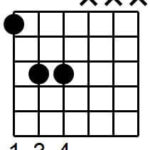The Fmaj7 guitar chord, often notated as Fmaj7, brings a unique and sophisticated flavor to your guitar playing. It possesses a character that balances a sense of restrained energy with a smooth calmness. Similar to its close relatives, the F major and F minor chords, the Fmaj7 carries a weight of emotion, hinting at both contentment and underlying tension. Visually, the Fmaj7 chord shape on the guitar neck bears a resemblance to the C major chord, making it a common and comfortable transition in many musical pieces. Let’s delve into understanding and playing the Fmaj7 chord to enrich your guitar skills.
Getting Your Fingers on the Fmaj7 Chord
The most accessible and widely used voicing of the Fmaj7 chord is perfect for guitarists of all levels, especially beginners. This fundamental chord shape is a staple in countless songs and is an incredibly valuable addition to your chord vocabulary.
Sonically, the Fmaj7 chord evokes a feeling of tranquility layered over a subtle undercurrent of anticipation. It delicately treads the line between serenity and passion, with each quality tempering the other in a captivating way.
To form the Fmaj7 chord, begin by positioning your index finger on the 1st fret of the B string. Next, place your middle finger onto the 2nd fret of the G string. Finally, use your ring finger to fret the 3rd fret of the D string.
When strumming the Fmaj7, ensure you only strum from the D string downwards, letting the high E string ring openly and avoiding the low E and A strings. Give this voicing a strum and listen to its distinctive sound!
Fmaj7 Chord: 1st Position Breakdown
- Index finger: 1st fret of the B (2nd) string
- Middle finger: 2nd fret of the G (3rd) string
- Ring finger: 3rd fret of the D (4th) string
Strum four strings down from the D string for the Fmaj7 chord.
Unpacking the Notes Within the Fmaj7 Chord
The Fmaj7 chord is built upon a foundation of four notes, each playing a crucial role in its unique sound. It’s constructed using a root, a major third, a perfect fifth, and a major seventh interval from the root note, F. This major seventh interval is what distinguishes it from a simple F major chord and lends it that characteristic “maj7” quality. The specific notes that constitute the Fmaj7 chord are:
F, A, C, and E
The interplay of these notes creates the Fmaj7’s signature sound – a blend of resolution and yearning, often described as having a poignant or bittersweet character. It’s this combination that gives the Fmaj7 chord its evocative and emotionally charged sound.
Songs That Showcase the Fmaj7 Chord
The Fmaj7 chord’s versatility allows it to add depth and emotion across diverse musical genres, from pop and rock to folk and beyond. Exploring songs that feature the Fmaj7 is an excellent way to train your ear and practice incorporating this chord into your playing. Here are some notable examples to get you started:
Fmaj7 in Pop Music
In “Cherish“ by The Association, the Fmaj7 chord contributes to the song’s gentle and heartwarming melody, creating a smooth and evolving harmonic progression. This classic song, also covered by artists like David Cassidy and Nina Simone, exemplifies the Fmaj7’s ability to add a touch of sophistication to pop arrangements.
“Tongue Tied” by Grouplove utilizes the Fmaj7 to inject a sense of vibrant tension into this energetic dance track. The chord’s inherent push and pull dynamic complements the song’s catchy rhythm and creates a feeling of exhilarating release within the music.
Fmaj7 in Rock Music
“Clocks” by Coldplay opens with iconic piano chords, immediately establishing the Fmaj7’s inherent grace and balance. Throughout the song, the Fmaj7 navigates between moments of calm introspection in the verses and builds towards powerful crescendos in the chorus, showcasing its dynamic emotional range within a rock context.
“Closer to the Heart” by Rush, a softer rock anthem, beautifully explores the emotional nuances of the Fmaj7 chord. Beginning with a delicate acoustic soundscape, the song gradually escalates to heavier, impactful riffs, all underpinned by Geddy Lee’s signature bass lines, demonstrating the chord’s power in building dynamics.
“Easy” by The Commodores highlights the gentler side of the Fmaj7 in what’s considered by many as the perfect Sunday morning song. This piano-driven ballad utilizes the Fmaj7 to create a soothing and inviting atmosphere. Faith No More’s electric guitar rendition of this classic retains the original’s essence while adding the band’s unique musical stamp, further illustrating the Fmaj7’s adaptability.
“Live Forever” by Oasis masterfully contrasts Liam Gallagher’s raw and emotive vocals with the composed and clean instrumental backdrop, a hallmark of the Fmaj7 chord’s character. The interplay between angst and composure is central to the song’s impact, perfectly embodied by the Fmaj7’s presence.
“One” by U2 is a masterclass in utilizing the Fmaj7 chord to build emotional depth. From the poignant lyrics to the evocative guitar tones and rhythmic elements, “One” showcases how the Fmaj7 can be used to create a musical journey that moves from vulnerability to resolution.
Fmaj7 in Folk Music
“Ho Hey” by The Lumineers effectively builds upon the Fmaj7 chord progression, starting with a simple acoustic guitar opening and gradually layering in additional instruments and band members. This song exemplifies how the Fmaj7 can contribute to a song’s organic growth and emotional build-up in a folk setting.
Practice the Fmaj7 chord diligently and experiment with different chord pairings to discover new dimensions of this potent yet accessible chord. Its expressive nature makes it a rewarding chord to master and incorporate into your guitar playing.
To expand your chord knowledge, be sure to explore Fender Play’s comprehensive chord library for a wealth of resources. And if you’re ready to take your guitar journey further, sign up for a free Fender Play trial.

